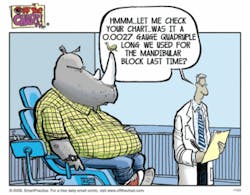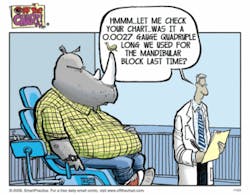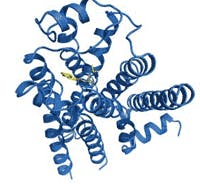Reader's Forum
Dear RDH:
I read Dr. David Boag's Letter to the Editor in the May issue of RDH magazine and felt compelled to comment. First, I wish to applaud Dr. Boag for his commitment to the periodontal health of his patients and for his willingness to stand up for what is right. I have worked for, and with, many clinicians who, unfortunately, are more concerned about driving the profit motive than with setting a standard of clinical excellence. I have always believed that for practitioners who work in an ethical manner, putting clinical excellence first will be more successful in the long run.
His message to RDH readers comes at a time when we are all soul searching and trying to provide excellent care to our patients, many of whom are financially strapped today.
As he already stated, it all comes down to character: doing the right thing when no one is watching. I was exposed to this law early on in Sunday School classes. As a young child, my parents hung a framed needlepoint picture in my bedroom and it read: "Do unto others as you would have them do unto you."
Like most people, I have been challenged over the years to do what is right, and the truth is that doing what is right or required in a given situation is not always easy nor is it always recognized or appreciated.
I've made many mistakes over the years and I've learned, as he said in his letter, that "there is often a cost to stand up for doing what is right." Learning to enjoy "the consequences of your choices" is the toughest part, though, because there is often a lot of pain associated with doing the right thing. The cliché "what goes around, comes around" is also very helpful to remember, because I've always found that the pursuit of good karma offers an opportunity for growth. We've all had to resolve negative forces and actions (some of which are self-inflicted), and we are often faced with a choice: Either we can choose to lash out at someone who offends us, or try to understand and forgive that person. We all possess a modicum of free will, and we can choose to walk away from a bad situation or live with the consequences of inaction. Ain't life grand?
As the Periodontal Therapy columnist for RDH magazine, I also feel compelled to praise Dr. Boag for his commitment to annual full-mouth periodontal probing. Once a dental practice chooses to commit to periodontal excellence (in his case, it comes from the employer/leader ... even better!), it's easier for the rest of the dental team to sign on and follow an example. Keep in mind that a comprehensive periodontal exam requires more than circumferential probing: numbers on their own often give us limited information. There are many patients who have 5 mm periodontal pockets who are healthy — i.e., the site is stable and there is no bleeding on probing. On the other hand, a patient might present with a 5 mm bleeding pocket on a tooth with 4 mm of recession. This is indeed a more unstable site!
Disease activity needs to be monitored by focusing on attachment loss. Periodontal probing once a year without looking at other variables such as smoking, bleeding, and mobility (just to name a few) is not always meaningful. That's one reason why I think it makes sense to use a risk assessment tool for periodontal infection because we can calculate who is at greater risk for attachment loss before the damage is done.
In summary, I enjoyed reading Dr. Boag's letter and wish him continued success that I know will be his in the future. The good example he set for his team and for all who work around him will lead to continued good karma, too, and many satisfied and lifelong patients.
Lynne H. Slim, RDH, MS
Atlanta, Georgia
Dear RDH:
How ironic! One of the most striking articles I have read in a number of years about domestic abuse is dated February 2008 in RDH magazine titled, "Domestic Abuse." In that same month in 1992, I fled for my life and left my husband of eight years. It was also during this month that I lived at a battered women's shelter and began a new, independent life. The life I had years ago seems to be merely yesterday when I remember.
I did not expect an article to have quite the impact on me as the one in RDH did, and those words, "Domestic Abuse" hit me like a vicious, unexpected slap in the face. For quite some time, I had not visited that uneasy memory of February 1992, and I was startled to read an article that described my past condition so clearly and precisely. I call it a condition because anyone enduring this type of treatment will not be healthy mentally or physically, and the one being abused begins to believe that somehow they deserve the torment.
As I read about the five actions associated with domestic abuse, I could feel my heart pounding, and as I continued to read, it seemed like I would never reach the end of the article; time seemed to stop. I was reminded of an incredibly different world in which I had lived being married to an abuser. Although I was startled by the article, I yearned to read more, and as I read it, I couldn't read the article fast enough — yet I was done reading it in no time. I had to read it several times.
While I read, I felt a humbleness come over me as I remembered the trials I encountered while breaking away from a controlling husband. The article in RDH triggered a backward glimpse as I saw myself, a young mother, reliving being married. I remembered the fears, the tears, and the longing for someone to understand my side of the situation, when I, myself could not understand it. Those five actions associated with domestic abuse were all equally present during my marriage. Yet for many years, it was difficult to admit that I was a battered wife. The abuse I put up with was not easy to admit as actual abuse. Abuse, to me, was when a woman was put in the hospital with visible broken bones and bruises. On the contrary, as the article explains, many abused women do not show many outward signs — thus it is difficult to recognize the victim.
It is true that victims, as the article states, become very good at hiding their emotions, as well as any bruises they have. In this type of environment, the victim feels a lot of shame. Therefore, they want to keep the abuse hidden. Victims also try endlessly to please the abuser to no avail. The abuser gains complete control by manipulation, physical abuse, fear tactics, and belittling. One thing many victims do not understand is that they can get out and get help.
In March 2008, RDH continued with more information on abuse concerning the cycle of violence. One very important aspect in this article is realizing that, if you are a victim, you are not alone. Many victims such as myself are isolated from family and friends. If the one being abused is allowed to have a job, which I was not, then the workplace could become their refuge and quite possibly a co-worker could provide advice and help.
As I mentioned before, I fled with my children more than 16 years ago and sought help at a battered women's shelter. While at the shelter, I underwent counseling, emotional healing, and direction on how to gain self-confidence and financial independence. Initially, when I moved to the shelter, I had no job, no car, very little money, no home, and no self-esteem. I did not even have a driver's license, because my husband destroyed it to further isolate me.
I am writing this to testify that coming from nothing does not indicate that you will always have nothing. If you are being abused in any way, seek help. If you cannot rely on family or friends, the police can come and take you to safety. Go to a shelter and let the counselor there show you what to do. By staying at a shelter you will have time to plan a future without being bullied by your abuser. You will be safe there.
Through a lot of hard work and determination, I put myself through dental hygiene school. It was not an easy row to hoe, but I am thankful I did. Although it was difficult to go back to school, it paled in comparison to living in an abusive marriage. I was able to bring my nose up to the pride level and gain financial independence, but not without criticism from my ex-husband. He continued to emotionally badger me long after I filed for divorce and moved from the shelter. But with the therapy I received at the shelter, I was able to push his remarks aside and keep focusing on my goal of success.
There is no shame in seeking help and receiving hours of counseling. It was worth it. My self-esteem was augmented by the counseling, by sticking to the goal of going back to school, and by eventually obtaining a degree. I succeeded in college and acquired a dental hygiene degree in 1999, and I am currently working in this field. Furthermore, I am now buying my own home and contributing to my employer's retirement fund.
I do not want you to think that I am tooting my own horn; I want you to realize that this type of achievement coming from having nothing is quite possible no matter which degree you go for. I also do not want you to feel sorry for me because I am a much healthier person due to the difficult times I have survived. Even though it did not feel like it at the time, suffering does make one a stronger person.
I chose dental hygiene for many reasons. But the most important reason was so I could have evenings and weekends at home with my children. By this fall, they will be a junior and a senior in college. When I left their father, they were both in preschool. Thankfully, I was able to attend all my schooling on a part-time basis while holding down a part-time job. By the time they were in middle school, I had entered the workforce as a hygienist full time, and I have never looked back or wished I had stayed in that abusive marriage. Furthermore, my faith in God has kept me steady throughout these years.
Going back to school with children and holding down a part time job was not easy. In the beginning as I filed for divorce, there was a great deal of upheaval and confusion, and there were times when I questioned whether it was all worth the trouble. However, I kept remembering the isolation and violence when I was married and that memory brought about determination to never return to that way of life. My determination actually grew as I acquired the needed credits in my dental hygiene courses. I decided to keep my eye on the goal at the end of the tunnel and keep plugging away at the needed credits.
It is probably difficult for others to understand the many hurdles I had to jump in order to achieve my dental hygiene degree. I had to worry about car repairs, getting to my classes, and searching for reliable child care. I had to maintain the household chores, do the yard work, study, pay the bills, and keep everything else in order on my own. But it can be done; I am living proof. There was not much rest, but being married to an abusive spouse offered no rest, anyway.
I cannot put everything I have learned about being single and going back to school into this letter. The finances were probably the worst part, but I discovered quickly how to make a dollar stretch. Although my ex-husband was court ordered to pay support, he didn't for years. Many fathers still get by with not fulfilling their obligation to their children. Eventually, his wages were garnished after I could afford an attorney to enforce this.
I believe enduring adversity and overcoming trials enables one to learn and become a better person, and thus be able to lend a helping hand to someone else. One way of helping is by understanding when someone else encounters the same situation. In my case, I can identify a woman who is being abused, simply because she acts the way I acted. One very striking feature of abused persons is that they walk with their shoulders slumped and their head held down. They also cannot look anyone in the eye. It is very difficult to start a conversation with these type of people because of the shame that they feel.
In the RDH articles, the authors spoke about being able to identify an abused person if she is a patient. However, unfortunately, she very likely is not allowed to go for any type of treatment. In my situation, medical and dental care was not an option. Also, while at the women's shelter, I discovered the majority of the women had no job, so I believe many battered wives are not allowed to work outside the home. The abuser thrives on keeping the abuse a secret and keeping the victim isolated as much as possible. The one committing the abuse does not want to be identified.
I believe abuse can begin at a young age. One focus during my daily routine of seeing patients is trying to open the lines of communication by asking teenage girls if they have a boyfriend. I do not look at it as prying, because I begin by asking other questions, such as: "Do you have fun in school? You are sixteen. Do you have your own car? Are you going to prom?" Building a rapport this way allows some trust, then I ask about the boyfriend and I simply say, "He's nice to you isn't he?" Then I try to reinforce their self-esteem by stating that they are worth having a nice boyfriend. I also try to mention parents in the conversation and find out if mom and dad approve of the boyfriend.
My interaction with the young girls occurs nonchalantly, but I hope this small conversation will instill a sort of confidence in them. I believe beginning in the teenage years will bring about insight and perhaps make a difference in someone's life. Conversely, while I understand that boys can also be abused, girls are more likely to find themselves in this sort of predicament. My hope is to break the cycle of violence, as the articles stress, and starting at this young and tender age will possibly enlighten young girls that they deserve a loving, non-abusive husband. Hopefully my short conversations will introduce the young girls to a healthy self-worth and self-respect.
In conclusion, I would like to thank Anastasia Turchetta and Teresa Duncan for doing the research needed to compile the articles in RDH. It was a great relief to read articles that are geared toward educating co-workers. There are many stigmas regarding this subject and the public also needs to be educated on domestic violence. Both of the articles have very accurate points, and my hope is that through education all those involved will know the facts and thus possibly render help.
Lila Rombold, LDH
Logansport, Indiana
To submit letters to the editor, send to: RDH, P.O. Box 3408, Tulsa, OK 74101; [email protected]; or (918) 831-9804 (fax).
A Moment in Dental Science
Protein in the Diet: Who Knew?*
Protein in the Diet: Who Knew?*
Protein's role in oral health:
- Can help neutralize acids produced by oral biofilm.
- Is essential for cellular defenses against subgingival oral biofilm.
- Is essential for healing and repair of tissue after periodontal trauma or surgery.
Possible deficiency in poorly-planned strict vegan diets (consisting only of plant foods):
- Adequate as long as caloric intake is adequate and variety of foods is eaten.
- Easier to achieve with diets that include dairy products and eggs (lacto-ovo-vegetarian).
- Harder to achieve with diets consisting only of fruits and vegetable oils (fruitarian diets).
Overconsumption of protein (i.e. Atkins diet, with low-carbohydrates):
- May effect calcium balance if inadequate calcium.
- May stress liver and kidneys due to presence of excess ketones, especially if already damaged.
- May cause halitosis.
* From Review of Dental Hygiene, 2nd edition, Saunders/Elsevier, In Press, 2009 (Fehrenbach, Weiner).


